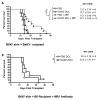Tolerogenic Donor-Derived Dendritic Cells Risk Sensitization In Vivo owing to Processing and Presentation by Recipient APCs
- PMID: 23536635
- PMCID: PMC3736316
- DOI: 10.4049/jimmunol.1200870
Tolerogenic Donor-Derived Dendritic Cells Risk Sensitization In Vivo owing to Processing and Presentation by Recipient APCs
Abstract
Modification of allogeneic dendritic cells (DCs) through drug treatment results in DCs with in vitro hallmarks of tolerogenicity. Despite these observations, using murine MHC-mismatched skin and heart transplant models, donor-derived drug-modified DCs not only failed to induce tolerance but also accelerated graft rejection. The latter was inhibited by injecting the recipient with anti-CD8 Ab, which removed both CD8(+) T cells and CD8(+) DCs. The discrepancy between in vitro and in vivo data could be explained, partly, by the presentation of drug-modified donor DC MHC alloantigens by recipient APCs and activation of recipient T cells with indirect allospecificity, leading to the induction of alloantibodies. Furthermore, allogeneic MHC molecules expressed by drug-treated DCs were rapidly processed and presented in peptide form by recipient APCs in vivo within hours of DC injection. Using TCR-transgenic T cells, Ag presentation of injected OVA-pulsed DCs was detectable for ≤ 3 d, whereas indirect presentation of MHC alloantigen by recipient APCs led to activation of T cells within 14 h and was partially inhibited by reducing the numbers of CD8(+) DCs in vivo. In support of this observation when mice lacking CD8(+) DCs were pretreated with drug-modified DCs prior to transplantation, skin graft rejection kinetics were similar to those in non-DC-treated controls. Of interest, when the same mice were treated with anti-CD40L blockade plus drug-modified DCs, skin graft survival was prolonged, suggesting endogenous DCs were responsible for T cell priming. Altogether, these findings highlight the risks and limitations of negative vaccination using alloantigen-bearing "tolerogenic" DCs.
Figures








Similar articles
-
Copresentation of intact and processed MHC alloantigen by recipient dendritic cells enables delivery of linked help to alloreactive CD8 T cells by indirect-pathway CD4 T cells.J Immunol. 2013 Jun 1;190(11):5829-38. doi: 10.4049/jimmunol.1300458. Epub 2013 Apr 29. J Immunol. 2013. PMID: 23630361 Free PMC article.
-
Continuous Acquisition of MHC:Peptide Complexes by Recipient Cells Contributes to the Generation of Anti-Graft CD8+ T Cell Immunity.Am J Transplant. 2017 Jan;17(1):60-68. doi: 10.1111/ajt.13996. Epub 2016 Sep 14. Am J Transplant. 2017. PMID: 27495898 Free PMC article.
-
CD8 T-cell recognition of acquired alloantigen promotes acute allograft rejection.Proc Natl Acad Sci U S A. 2015 Oct 13;112(41):12788-93. doi: 10.1073/pnas.1513533112. Epub 2015 Sep 29. Proc Natl Acad Sci U S A. 2015. PMID: 26420874 Free PMC article.
-
Pathways of allorecognition: implications for transplantation tolerance.Transpl Immunol. 2002 Aug;10(2-3):101-8. doi: 10.1016/s0966-3274(02)00055-2. Transpl Immunol. 2002. PMID: 12216939 Review.
-
Dendritic cells expand antigen-specific Foxp3+ CD25+ CD4+ regulatory T cells including suppressors of alloreactivity.Immunol Rev. 2006 Aug;212:314-29. doi: 10.1111/j.0105-2896.2006.00422.x. Immunol Rev. 2006. PMID: 16903923 Review.
Cited by
-
Immunosuppressive human anti-CD83 monoclonal antibody depletion of activated dendritic cells in transplantation.Leukemia. 2016 Mar;30(3):692-700. doi: 10.1038/leu.2015.231. Epub 2015 Aug 19. Leukemia. 2016. PMID: 26286117
-
Effect of immune tolerance induced by immature dendritic cells and CTLA4-Ig on systemic lupus erythematosus: An in vivo study.Exp Ther Med. 2018 Mar;15(3):2499-2506. doi: 10.3892/etm.2018.5697. Epub 2018 Jan 4. Exp Ther Med. 2018. PMID: 29456655 Free PMC article.
-
Dendritic Cells in Xenotransplantation: Shaping the Cellular Immune Response Toward Tolerance.Xenotransplantation. 2025 Mar-Apr;32(2):e70037. doi: 10.1111/xen.70037. Xenotransplantation. 2025. PMID: 40243284 Free PMC article. Review.
-
March1-dependent modulation of donor MHC II on CD103+ dendritic cells mitigates alloimmunity.Nat Commun. 2018 Aug 28;9(1):3482. doi: 10.1038/s41467-018-05572-z. Nat Commun. 2018. PMID: 30154416 Free PMC article.
-
Update on Dendritic Cell-Induced Immunological and Clinical Tolerance.Front Immunol. 2017 Nov 20;8:1514. doi: 10.3389/fimmu.2017.01514. eCollection 2017. Front Immunol. 2017. PMID: 29250057 Free PMC article. Review.
References
-
- Lechler RI, George AJT. Transplantation and Rejection. In: Male D, Brostoff J, Roth DB, Roitt I, editors. Immunology. 7th ed Mosby Elsevier; Philadelphia: 2006. pp. 383–399.
-
- Long E, Wood KJ. Regulatory T Cells in Transplantation: Transferring Mouse Studies to the Clinic. Transplantation. 2009;88:1050–1056. - PubMed
-
- Feng G, Chan T, Wood KJ, Bushell A. Donor reactive regulatory T cells. Curr Opin Organ Transplant. 2009;14:432–438. - PubMed
-
- Silk KM, Fairchild PJ. Harnessing dendritic cells for the induction of transplantation tolerance. Curr Opin Organ Transplant. 2009;14:344–350. - PubMed
-
- Hackstein H, Thomson AW. Dendritic cells: emerging pharmacological targets of immunosuppressive drugs. Nat Rev Immunol. 2004;4:24–34. - PubMed
MeSH terms
Substances
Grants and funding
LinkOut - more resources
Full Text Sources
Other Literature Sources
Molecular Biology Databases
Research Materials
Miscellaneous

